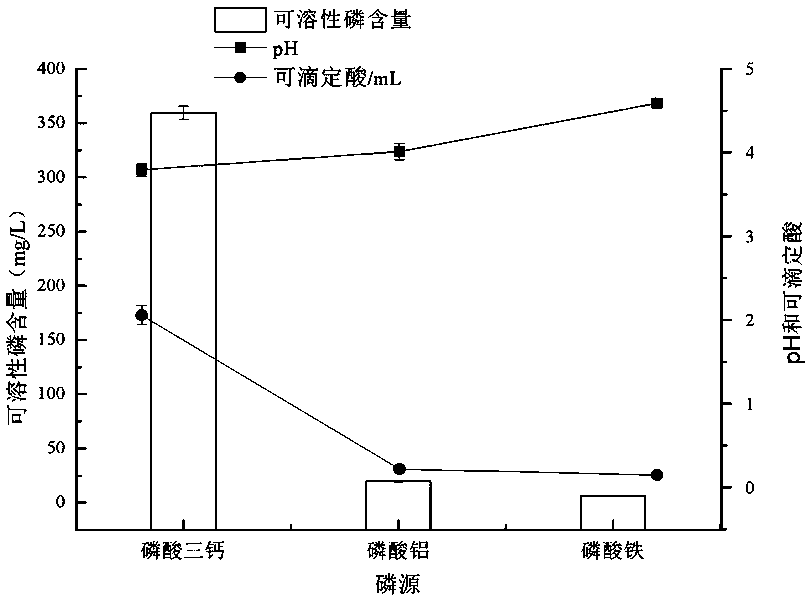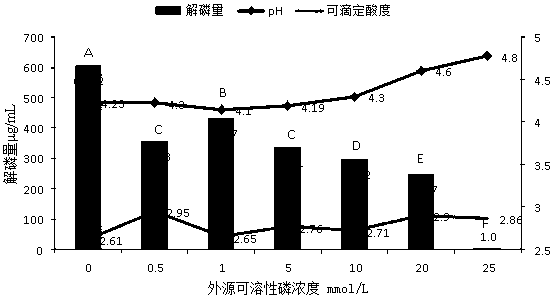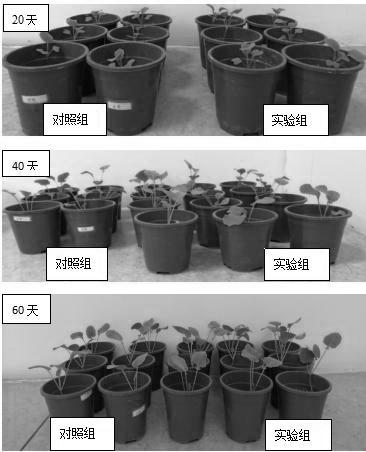Inorganic Phosphorus-decomposing Bacteria in the Rhizosphere of a Poplar and Its Application
A technology for decomposing inorganic phosphorus bacteria and inorganic phosphate, which is applied in the field of agricultural microorganisms, can solve the problem of less phosphorus decomposing bacteria, achieve stable phosphorus decomposing ability, strong dissolving ability, and promote growth
- Summary
- Abstract
- Description
- Claims
- Application Information
AI Technical Summary
Problems solved by technology
Method used
Image
Examples
Embodiment 1
[0021] Embodiment 1: the dissolving ability of inorganic phosphorus bacterium Mp1-Ha3 to different phosphorus sources
[0022] 1. Medium formula
[0023] LB medium: tryptone 10g / L, yeast extract 5g / L, sodium chloride 10g / L, deionized water 1000mL, pH7.0.
[0024] NBRIP medium: glucose 10 g, Ca 3 (PO 4 ) 2 5 g, MgCl 2 .6H 2 O 5 g, KCl 0.2 g, MgSO 4 .7H 2 O 0.25 g, (NH 4 ) 2 SO 4 0.1 g, 1000 mL of distilled water, pH 7.0, when measuring the solubility of the strain to different phosphorus sources, the Ca in the medium formula should be 3 (PO 4 ) 2 Replaced by AlPO 4 or FePO 4 .
[0025] 2. Experimental method
[0026] The strain Mp1-Ha3 stored at -80°C was activated and transferred twice, then inoculated in LB liquid medium, and cultured at 28°C and 180 r / min for 12 h. Take 1 mL of bacterial liquid, centrifuge at 10,000 rpm for 1 min, remove the supernatant, and then wash twice with sterile distilled water to make seed liquid. Then inoculate the seed liquid i...
Embodiment 2
[0028] Example 2: Effects of Different Levels of Soluble Phosphorus Concentrations on Phosphorus Solubilizing Activity of Inorganic Phosphorus Solubilizing Bacteria Mp1-Ha3
[0029] 1. Medium
[0030] Exogenous soluble phosphorus source: 100mmol / L K 2 HPO 4 .
[0031] SP medium: glucose 10 g, (NH 4 ) 2 SO 4 0.6 g, KCl 0.4 g, Ca 3 (PO 4 ) 2 5 g, 1L deionized water, pH7.0.
[0032] 2. Experimental method
[0033] with K 2 HPO 4 (100 mmol / L) was the source of exogenous soluble phosphorus, and the SP medium with final concentrations of exogenous soluble phosphorus of 0, 0.5, 1.0, 5.0, 10.0, 20.0 and 25.0 mmol / L were prepared. Prepare the seed liquid according to the method of Example 1, insert the suspension of the inorganic phosphorus-solving bacteria Mp1-Ha3 into the SP liquid medium containing different concentrations of soluble phosphorus according to the inoculum size of 1%, and culture it with shaking at 180 rpm and 28°C 2 days. Three replicates were set up for...
Embodiment 3
[0035] Embodiment 3: the influence of inorganic phosphorus bacterium Mp1-Ha3 on rape inoculation
[0036] The tested soil formula: 85% quartz sand, 15% montmorillonite, 2% CaCO 3 , add 500mg Ca per kg soil 3 (PO 4 ) 2 . After mixing, sterilize at 121°C for 50 min.
[0037] experimental method:
[0038] (1) Seed sterilization: 200 rapeseed seeds were soaked in sterile water for 6-7 hours, and air-dried on a clean bench. They were then soaked in 30% sodium hypochlorite solution for 90 s for surface sterilization, and then rinsed three times with sterile water.
[0039] (2) Seed germination: Thoroughly sterilized rapeseed seeds were soaked in Mp1-Ha3 bacterial suspension and normal saline respectively. After soaking for 30 min, the seeds were air-dried in an ultra-clean workbench. The air-dried rape seeds were placed on the water agar plate medium, 12 seeds were placed on each plate, and five replicates were set up for each treatment. Cultivate at 28°C in the dark, observ...
PUM
 Login to View More
Login to View More Abstract
Description
Claims
Application Information
 Login to View More
Login to View More - R&D
- Intellectual Property
- Life Sciences
- Materials
- Tech Scout
- Unparalleled Data Quality
- Higher Quality Content
- 60% Fewer Hallucinations
Browse by: Latest US Patents, China's latest patents, Technical Efficacy Thesaurus, Application Domain, Technology Topic, Popular Technical Reports.
© 2025 PatSnap. All rights reserved.Legal|Privacy policy|Modern Slavery Act Transparency Statement|Sitemap|About US| Contact US: help@patsnap.com



